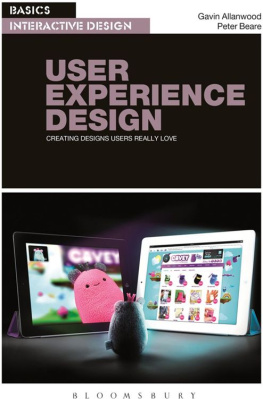
UX For Dummies
Published by John Wiley & Sons, Ltd, The Atrium, Southern Gate,
West Sussex, PO19 8SQ, England
E-mail (for orders and customer service enquires):
Visit our home page on www.wiley.com
Copyright 2014 John Wiley & Sons, Ltd, Chichester, West Sussex, England
Published by John Wiley & Sons Ltd, Chichester, West Sussex
All rights reserved. No part of this publication may be reproduced, stored in a retrieval system or transmitted in any form or by any means, electronic, mechanical, photocopying, recording, scanning or otherwise, except under the terms of the Copyright, Designs and Patents Act 1988 or under the terms of a licence issued by the Copyright Licensing Agency Ltd., Saffron House, 6-10 Kirby Street, London EC1N 8TS, UK, without the permission in writing of the Publisher. Requests to the Publisher for permission should be addressed to the Permissions Department, John Wiley & Sons, Ltd, The Atrium, Southern Gate, Chichester, West Sussex, PO19 8SQ, England, or emailed to , or faxed to (44) 1243 770620.
Trademarks: Wiley, For Dummies, the Dummies Man logo, Dummies.com, Making Everything Easier, and related trade dress are trademarks or registered trademarks of John Wiley & Sons, Inc. and/or its affiliates in the United States and other countries, and may not be used without written permission. All other trademarks are the property of their respective owners. John Wiley & Sons, Ltd. is not associated with any product or vendor mentioned in this book.
LIMIT OF LIABILITY/DISCLAIMER OF WARRANTY : THE PUBLISHER, THE AUTHOR, AND ANYONE ELSE IN PREPARING THIS WORK MAKE NO REPRESENTATIONS OR WARRANTIES WITH RESPECT TO THE ACCURACY OR COMPLETENESS OF THE CONTENTS OF THIS WORK AND SPECIFICALLY DISCLAIM ALL WARRANTIES, INCLUDING WITHOUT LIMITATION WARRANTIES OF FITNESS FOR A PARTICULAR PURPOSE. NO WARRANTY MAY BE CREATED OR EXTENDED BY SALES OR PROMOTIONAL MATERIALS. THE ADVICE AND STRATEGIES CONTAINED HEREIN MAY NOT BE SUITABLE FOR EVERY SITUATION. THIS WORK IS SOLD WITH THE UNDERSTANDING THAT THE PUBLISHER IS NOT ENGAGED IN RENDERING LEGAL, ACCOUNTING, OR OTHER PROFESSIONAL SERVICES. IF PROFESSIONAL ASSISTANCE IS REQUIRED, THE SERVICES OF A COMPETENT PROFESSIONAL PERSON SHOULD BE SOUGHT. NEITHER THE PUBLISHER NOR THE AUTHOR SHALL BE LIABLE FOR DAMAGES ARISING HEREFROM. THE FACT THAT AN ORGANIZATION OR WEBSITE IS REFERRED TO IN THIS WORK AS A CITATION AND/OR A POTENTIAL SOURCE OF FURTHER INFORMATION DOES NOT MEAN THAT THE AUTHOR OR THE PUBLISHER ENDORSES THE INFORMATION THE ORGANIZATION OR WEBSITE MAY PROVIDE OR RECOMMENDATIONS IT MAY MAKE. FURTHER, READERS SHOULD BE AWARE THAT INTERNET WEBSITES LISTED IN THIS WORK MAY HAVE CHANGED OR DISAPPEARED BETWEEN WHEN THIS WORK WAS WRITTEN AND WHEN IT IS READ.
For general information on our other products and services, please contact our Customer Care Department within the U.S. at 877-762-2974, outside the U.S. at 317-572-3993, or fax 317-572-4002.
For technical support, please visit www.wiley.com/techsupport .
Wiley also publishes its books in a variety of electronic formats and by print-on-demand. Some content that appears in standard print versions of this book may not be available in other formats. For more information about Wiley products, visit us at www.wiley.com .
British Library Cataloguing in Publication Data: A catalogue record for this book is available from the British Library.
ISBN 978-1-118-85278-1 (pbk); ISBN 978-1-118-85271-2 (ePub); 978-1-118-85279-8 (ePDF)
Printed and bound in the United States by Bind-Rite.
10 9 8 7 6 5 4 3 2 1

Glossary
- A/B testing: A technique used where two different variables are tested to see how each affects a users behavior. For example, two different types of navigation buttons may be used to see which button results in the most clicks. See also usability testing.
- abandonment rate: The rate at which an action is abandoned prior to completion (conversion). For example, if a typical conversion is purchase of a product, the rates at which users abandon or leave a journey prior to completing the purchase.
- accessibility testing: Testing for how easy to use a solution is for all types of users; generally, testing is designed to ensure a solution is accessible for all users, such as those who are visually impaired or deaf.
- agile methodology: A project management and software development process that is highly iterative, in which tasks occur concurrently and often without the completion of previous tasks. Generally, agile development is more nimble and faster (but not necessarily a better approach in all cases) than a waterfall approach, which assumes certain tasks are complete prior to engaging in subsequent tasks. See also waterfall methodology.
- analytics: The process of evaluating metrics, user research, and the overall performance of an experience to make recommendations for optimization. See also metrics.
- authentication: The process of confirming a users identity. For example, a user authenticates herself when she provides her credentials (username and password) to log into a user profile on a website. Authenticated users generally have a user profile stored in the experience.
- beta testing: Tests that occur after a prototype or beta version of the experience is complete. A beta is released for a group of users who are asked to complete a series of tasks (such as log into a screen), and then data and bugs are recorded.
- below the fold: A concept used in UX to indicate any information that falls under the visible area of a users browser basically, any information the user must scroll to see. Information above the fold generally has the highest priority because it is what a user sees first, requiring no interaction.
- brand guidelines: A set of documented standards for rules on how to represent a business corporate identity with visuals, text, and overall design within the UX. Guidelines often address logos, colors, typography, rules for voice and tone, and editorial conventions. For example, brand guidelines might specify which logos to use and where to place each within a page.
- browser testing: Testing how a digital UX renders on a particular browser or platform, such as how a website renders in Internet Explorer and Safari. Browser testing ensures that an experience renders appropriately across several different browsers and platforms.
- card sorting: An exercise conducted to see how users group and identify categories of information. This exercise is used to test how content should be organized for the purposes of designing taxonomy and navigation.
- channel: The various physical means through which an experience can be rendered, such as desktop, smartphone, tablet, in-store kiosk, and e-mail.
- cognitive overload: A point at which too much information is provided to a user to easily accomplish tasks or too many tasks are provided so the user cannot single out the most important for himself. Cognitive overload generally results in user frustration and abandonment.
- competitive benchmark: An evaluation of the competitive landscape to determine what competitors experiences offer. Competitive benchmarks uncover areas of opportunity, such as identifying functionality that can prove competitively differentiating as well as provide a baseline for what should be included within a future state experience.









